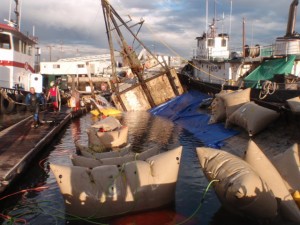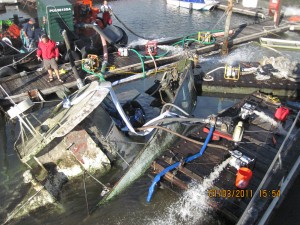TowBoatUS San Diego Raises 150 Ton Steel Boat


Vessel Assist San Diego specializes in raising boats after they sink. Weather the boat is in a slip or in 400’ of water Vessel Assist San Diego can raise it. Most boats that sink in slips are under 40’. The Cathy Ann was a steel commercial fishing vessel 80’ long and weighed over 150 tons with the cement ballast added inside the hull to stabilize her for the rough Pacific Ocean. Vessel Assist San Diego was given the task of raising the monster vessel from 50’ of water. The steel vessel offered many challenges. One, the sheer weight and steel hull with cement inside offered zero buoyancy. Two, the vessel was resting on a steep slope bottom leaving only the roof out of the water and the only accessible hatch 7’ under water on the lowest tides. Three the salvage had to be done on a negative tide making the start date of the job New Year’s Day.
Most boats are made of wood or fiberglass and have some natural buoyancy. Steel vessels only float because of displacement. The Salvage plan to re- float a steel boat of this size is to pump the water out and add air to replenish the displacement allowing it to float. With this vessel sitting in shallow water on the bow and deep water on the stern, float bags would have to be placed on the stern to get the stern of the vessel high enough to pump the remaining water out. A coffer dam was built 8’ high and installed on the bow hatch, the first 4’ welded aluminum and the top 4’ heavy plywood so it could be torn down once the bow rises.
Robert Butler (Owner of Vessel Assist San Diego) and his 8 man crew spent the holiday weekend installing the coffer dam and plugging various holes inside the boat. Salvage Divers Shane Thompson and Augustine Malfavon had to enter the dark sunken vessel through a tight hatch. The giant vessel had only two bulkheads, one about amidships and the other about 10 from the stern. These bulk heads made the giant fish hold for the once productive commercial fishing vessel. The bulk heads had several rotting holes in it. Captain Thompson ventured into the dark hull and placed damage control plugs in the various holes. The vessel was listing about 40 degrees to port lying on the bottom. A 6’ by 10’ steel hatch for the fish hold had to be placed back in position. This required Captain Tony Olson to get into his dive gear and with the assistance of a 2000 lb. float bag the three divers replaced and secured the heavy steel hatch. The deck was rusted and had no less than 100 small holes rotting through. Large tarps were attach to the deck and would suck down into the holes once the suction from the pumps pulled the water through the hull. Removing water volume in mass amount was planned to get the vessel removed from the clutches of the sticky mud. Two 6” trash pumps and ten 2” trash pumps would be needed to overcome the sheer weight and the mud suck to float the bow of the boat. With all the pumps pumping from the bow of the vessel through the coffer dam, over 6000 gallons per minute were being pumped. After an hour of pumping the bow came up out of the water as the front 30’ of vessel shot straight up. This presented a new challenge as the 10 2” pumps had to be shut down and disconnected before the pickup hoses pulled the pumps into the water. Captain Butler’s daughter, Hannah Butler, led a team of pump operators and quickly removed them and re positioned them to a new exposed hatch. One giant pump was shut down as one pump pumping 1800 gallons per minute was enough to stabilize the vessel and hold it in the upright position. Because the high tide was on its way in and the salvage crew had already been on the job for 72 hours, Captain Butler decided to maintain one giant pump until morning and let the crew rest for the night. Captain Greg Rood and Captain Butler maintained watch until morning. With the morning came new energy. The three Divers took turns adding floatation bags to the vessel until a total of 28 bags were placed giving 140,000lbs of lift. The vessel wanted to continue to rise straight up in the air and Captain Butler’s concern was the air in the lower part of the vessel overcoming the weight of the vessel and turning her upside down. High strength spectra line was place on the mast on the sides and on the bow. The bow line was attached to a block and tackle tied to a wench, and secured to cement blocks that made up the sea wall. With all the bags inflated to their maximum capacity tension was made on the bow. Damage control plugs were removed in the mid bulkhead to allow water in the front of the boat and air in the fish hold. The wench slowly pulled the bow down until the lift bags pulled the giant boat to the surface. Two hours later all the pumps were shut down and the sunken vessel was afloat where she belonged. A hole was found and patched the boat is now scheduled to be cut up for scrap.

